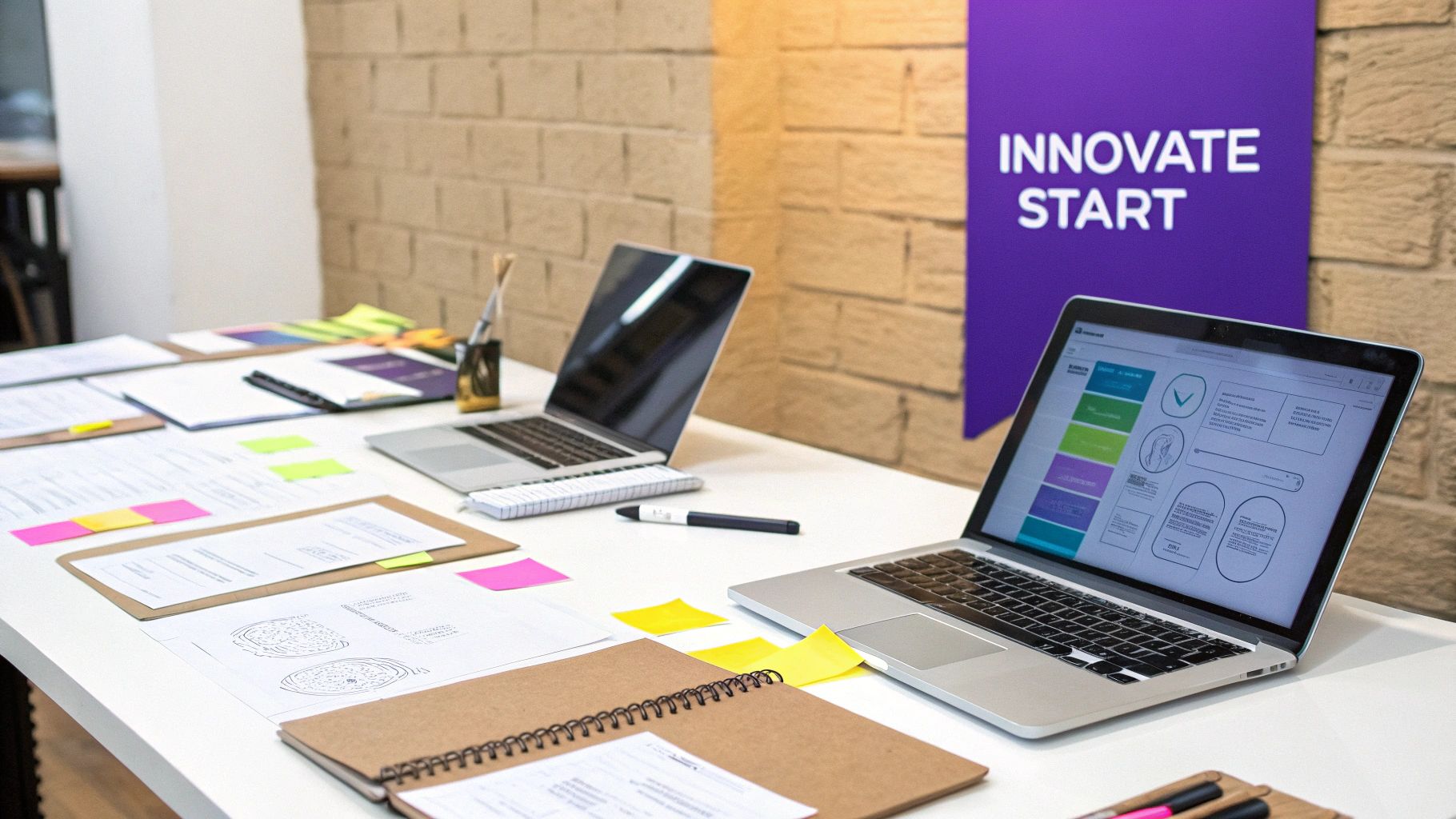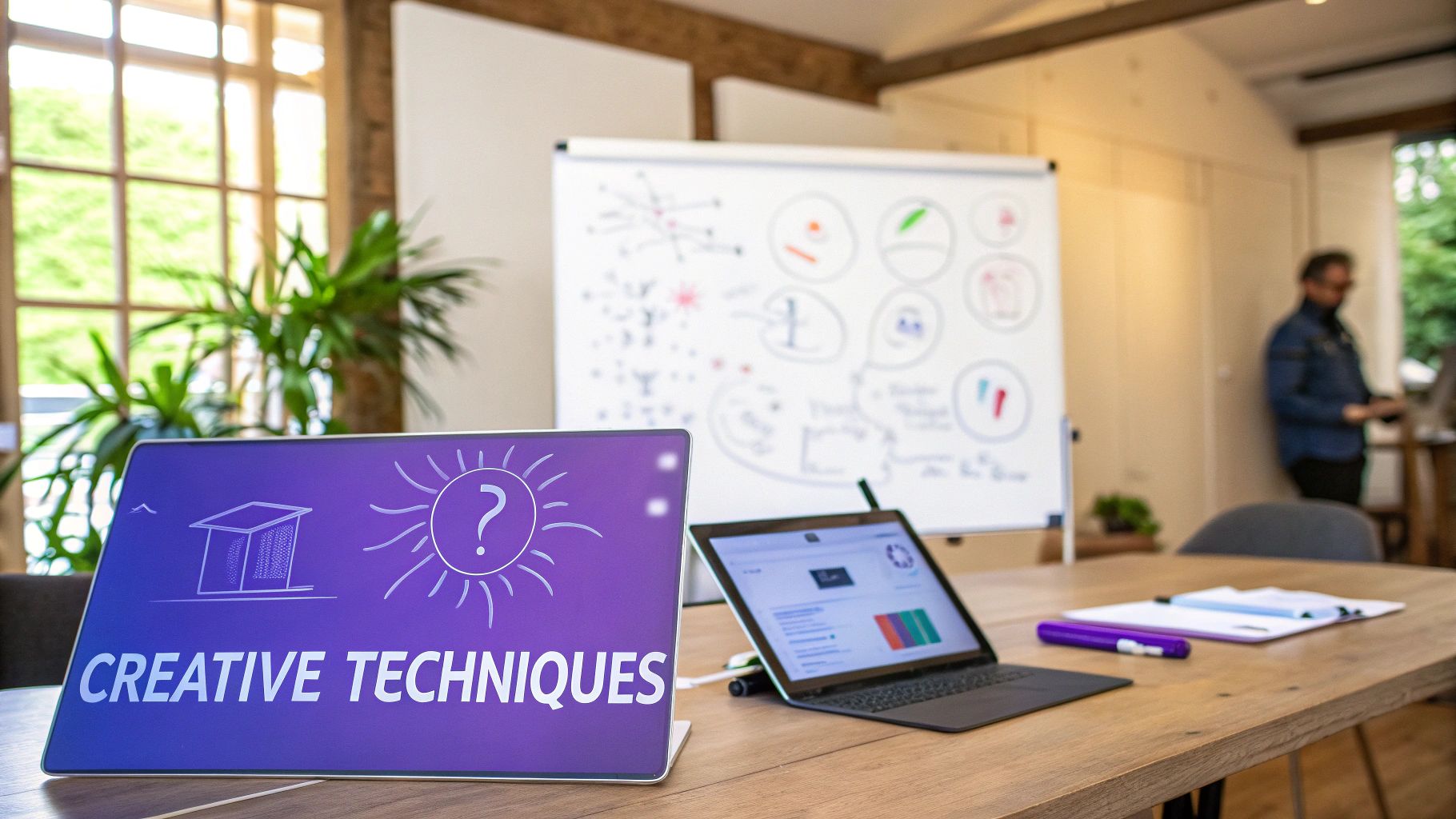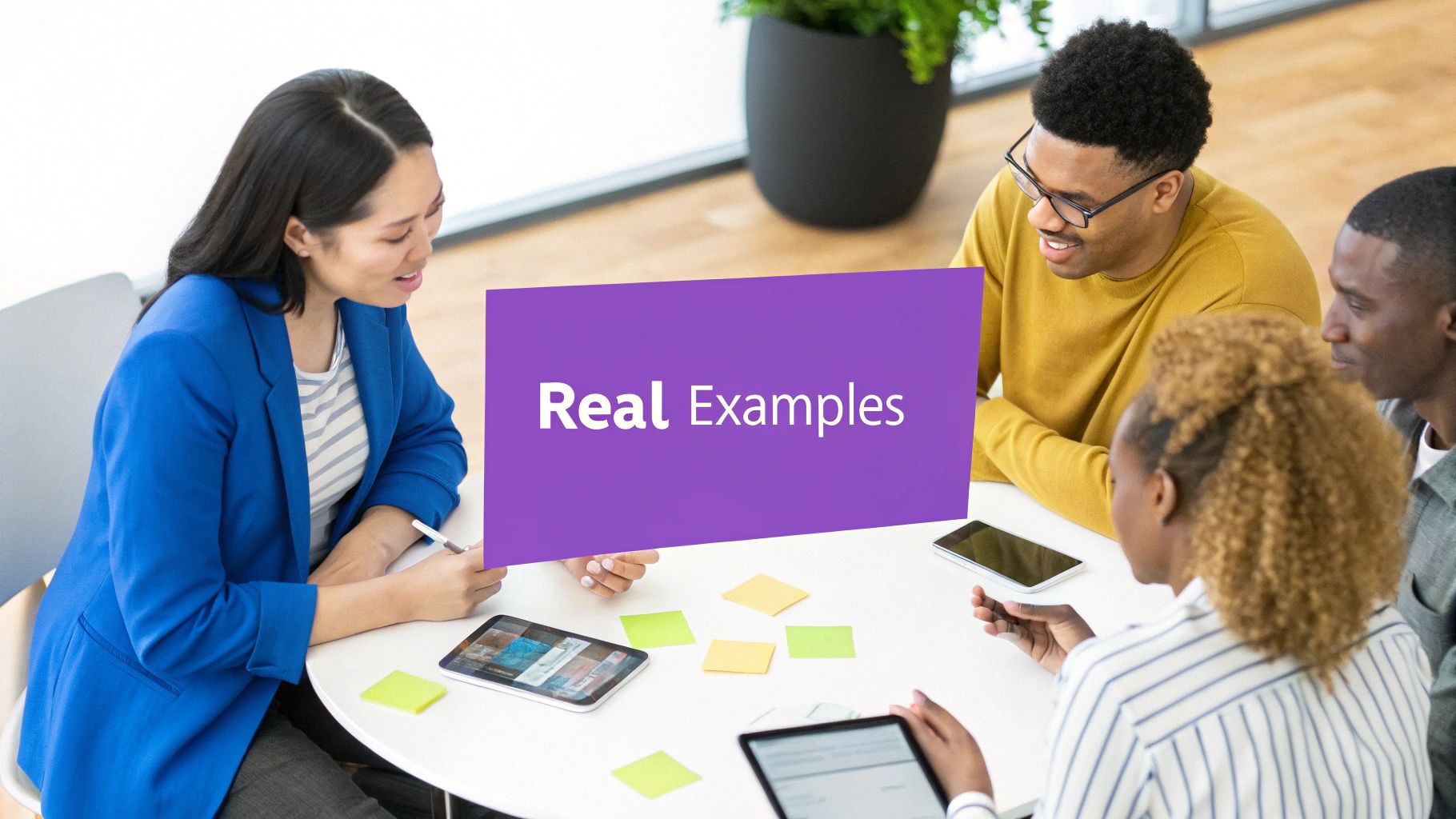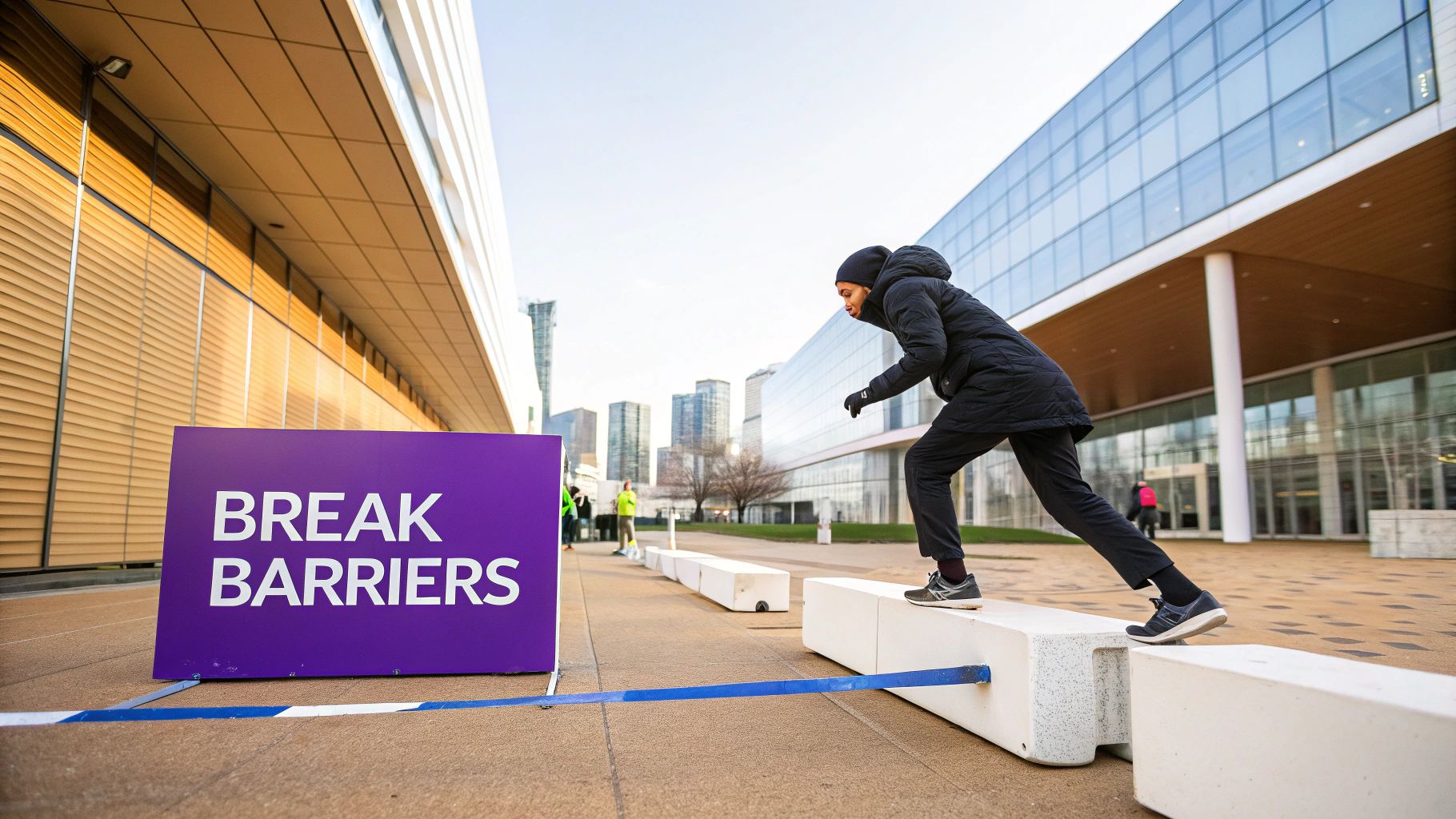Why Creative Problem Solving Matters More Than Ever

In today's intricate business world, traditional problem-solving methods often fall short. Companies face constant challenges, from emerging technologies to evolving customer expectations. This requires a shift toward creative problem solving. It's a skill vital for individuals and organizations looking to not just survive, but excel.
The Shift From Reactive to Proactive
Traditional problem-solving is often reactive, focusing on immediate issues as they appear. It’s like putting out fires—necessary at times, but it doesn't prevent future blazes. This approach fails to address the underlying causes, allowing issues to resurface.
Creative problem solving, on the other hand, is proactive. It involves anticipating potential challenges and developing innovative solutions before problems escalate. This proactive mindset is key for lasting success.
For instance, consider a software company dealing with customer complaints about a slow application. A reactive response might involve increasing server capacity. While this might offer a temporary fix, it doesn't solve the core problem.
A creative approach would involve analyzing the application's code for inefficiencies and optimizing its performance. This proactive solution not only addresses the current complaint, but also prevents future slowdowns and improves user experience.
Driving Innovation and Growth
Creative problem solving is more than just putting out fires; it fuels innovation and growth. Thinking outside the box and generating unique solutions unlocks new opportunities and establishes a competitive edge. In fact, 77% of senior company leaders see creativity as a key driver of growth.
Furthermore, the global Creative Industries market, heavily reliant on creative problem-solving, was valued at USD 2,669,224.0 million in 2022. It's projected to grow at a CAGR of 4.29% until 2031. This underscores the growing demand for creative solutions worldwide. For more detailed statistics, check out this resource: https://www.skillademia.com/statistics/creativity-statistics/
Empowering Individuals and Organizations
Creative problem solving empowers both individuals and organizations. For individuals, it promotes adaptability and resilience, allowing them to navigate challenges and flourish in a changing environment. For organizations, it fosters a culture of innovation, attracting talent and driving continuous improvement.
Teams that prioritize creative problem solving outperform their counterparts, developing more effective solutions and achieving greater success. This skill is no longer a bonus; it's a requirement for success in today’s dynamic world.
The Creative Problem Solving Framework That Actually Works
While understanding the why behind creative problem solving is crucial, knowing how to apply it is what truly makes a difference. This section presents a practical, proven framework you can use immediately to tackle any challenge.
Defining the Problem
The first step, often overlooked, is accurately defining the problem. This means going beyond surface-level symptoms to find the root cause. For example, if customer service calls are rising, simply hiring more representatives might be a temporary solution. A deeper look, however, might reveal the real problem is a confusing website, calling for a redesign. A precise problem definition sets the foundation for effective solutions.
Gathering Information Strategically
Once you've identified the problem, gathering the right information becomes essential. This isn't about collecting all data possible, but focusing on relevant sources that offer real insights. These sources could include customer feedback, market analysis, or internal reviews. The objective is to thoroughly understand the problem's context.
Structured Ideation: Generating a Multitude of Possibilities
With a strong understanding of the problem, the next step is structured ideation. This is where the creative aspect truly shines. Techniques like brainstorming, mind mapping, and lateral thinking are invaluable for generating diverse and potentially unconventional solutions. Aim for quantity and variety. Don't dismiss unusual ideas too quickly; they might lead to a breakthrough.
Rigorous Evaluation: Selecting the Best Path Forward
The ideation phase will likely generate many potential solutions. Now comes the critical step of evaluation. This means assessing each solution against criteria like feasibility, cost-effectiveness, and potential impact. A clear evaluation process avoids emotional attachment to a single idea and ensures the chosen solution meets your objectives. Often, the best solution comes from combining or adapting several initial ideas.
Implementation Planning: Turning Ideas Into Action
Finally, your chosen solution needs a solid implementation plan. This involves outlining specific steps, assigning responsibilities, setting deadlines, and allocating resources. A well-defined plan reduces obstacles and improves the chances of success. This turns a creative solution from an idea into reality.
Overcoming Common Pitfalls and Psychological Barriers
Throughout this framework, watch out for common pitfalls. Premature convergence, where a team focuses on the first seemingly good solution, can stifle innovation. Groupthink, where differing opinions are suppressed, can lead to poor outcomes. Creating a psychologically safe environment, where team members feel comfortable sharing unconventional ideas, is crucial for unlocking creative potential. Tools like Bulby can facilitate this process, especially for remote teams facing the challenges of virtual collaboration. Its structured brainstorming sessions and AI-powered guidance help overcome biases and encourage diverse thinking, leading to more creative and impactful solutions.
This framework is not a rigid, linear process. It’s an iterative cycle, where feedback and adjustments are key. By using this flexible, structured approach, you can transform creative problem solving from an occasional spark into a reliable, repeatable process for driving innovation and achieving outstanding results.
Powerful Techniques That Unlock Creative Solutions

We've established a solid framework for creative problem solving. Now, let's explore specific techniques that can help you generate innovative solutions. These are practical methods used by successful innovators across many industries. It's important to understand not only what these techniques are, but when and how to use them effectively. For a more detailed explanation, check out our guide on How to Master Creative Problem Solving Techniques for Breakthrough Innovation.
Constraint Reversal: Turning Limitations Into Advantages
Limitations can often be springboards for creativity. Constraint Reversal involves identifying existing constraints and flipping them to discover new possibilities. For example, a budget constraint might lead you to innovative, low-cost alternatives. These alternatives could ultimately prove more effective than the original, more expensive approach.
Time constraints can also force teams to prioritize and streamline processes. This often leads to increased efficiency over time. Constraint Reversal teaches us to see limitations not as roadblocks, but as opportunities for different thinking.
Analogical Thinking: Borrowing Brilliance From Other Fields
Analogical Thinking is another powerful technique. It involves drawing parallels between seemingly unrelated areas. This means looking at how problems are solved in other fields, and then adapting those solutions to your own situation.
For example, the efficient logistics of an ant colony could inspire new ways to optimize supply chain management for a business. This technique encourages us to broaden our search for inspiration, expanding the pool of potential solutions.
Provocation: Challenging Assumptions to Spark New Ideas
Sometimes, the best way to find a creative solution is to challenge the problem's underlying assumptions. Provocation involves making statements that seem illogical or contradictory. This can shake up conventional thinking.
This technique disrupts ingrained thought patterns and opens up new avenues for exploration. It's crucial to use provocation constructively. Focus on challenging the problem itself, not individuals or their ideas.
Systematic Combination: Exploring Synergies Between Existing Ideas
Systematic Combination involves exploring the potential of combining existing ideas in new ways. Breakthrough solutions often emerge not from entirely new concepts, but from the clever fusion of existing ones. Think of it like combining ingredients in cooking: familiar components can create entirely new flavors when combined.
This fosters a more holistic view of problem-solving. It encourages us to see the hidden potential within familiar elements.
Selecting the Right Technique for the Job
Knowing when to use each technique is essential. Some techniques are better for individual brainstorming, while others work best in groups. The complexity of the problem and the available time are also important factors.
Experimenting with different techniques and combinations allows you to customize your approach to each challenge. This maximizes your chances of finding effective and innovative solutions.
The following table summarizes these techniques:
Creative Problem Solving Techniques Comparison
| Technique | Main Benefit | Best For | Complexity Level | Time Required |
|---|---|---|---|---|
| Constraint Reversal | Transforms limitations into opportunities | Budget or time-sensitive projects | Low to Medium | Short to Medium |
| Analogical Thinking | Broadens perspectives and solution space | Complex problems requiring fresh insights | Medium to High | Medium |
| Provocation | Disrupts conventional thinking | Situations stuck in traditional approaches | Medium | Short to Medium |
| Systematic Combination | Leverages existing resources for new solutions | Projects with readily available components | Low to Medium | Short to Medium |
This table compares different creative problem-solving techniques, their primary benefits, ideal use cases, and difficulty level. As you can see, each technique offers unique advantages and is suited for different situations. By understanding these differences, you can choose the best approach for your specific challenge.
Developing Your Creative Problem Solving Mindset

Even with the most effective techniques, creative problem solving is impossible without the right mindset. This section explores the mental obstacles that can hold back our creative potential. We’ll look at roadblocks like fear of judgment and settling too quickly on the first solution that comes to mind. By understanding these limitations, we can build a stronger foundation for creative thinking.
Identifying and Overcoming Mental Barriers
One common barrier is the fear of failure. This can stop us from experimenting and lead us to censor our own ideas, limiting our creative range. Another obstacle is functional fixedness. This is the tendency to see objects and concepts only in their usual way, making it difficult to think outside the box and come up with innovative uses.
Also, confirmation bias can hold us back. This is our tendency to look for information that agrees with what we already believe. It can stop us from considering different perspectives and lead us to miss valuable insights and potentially better solutions.
Cultivating Essential Creative Thinking Habits
To get past these barriers, we need to develop good creative thinking habits. This includes challenging assumptions, questioning the way things are usually done, and looking for new ways to understand information. Perspective shifting is also key. Try looking at the problem from various points of view, putting yourself in the shoes of different people involved. This can open up new possibilities.
Finally, productive failure analysis is a valuable tool. Instead of focusing on blame, we should analyze mistakes to learn from them and improve our approach for the future. These habits can be strengthened through dedicated brainstorming, engaging in different kinds of thinking (like puzzles or creative writing), and getting feedback from a variety of sources. For more ideas, check out this article on How To Master Creative Problem Solving and Innovation.
Building a Framework for Innovative Solutions
Developing a creative problem-solving mindset requires mental frameworks that encourage innovation. One key element is embracing ambiguity. This means being comfortable with not knowing all the answers right away and resisting the urge to jump to conclusions. Taking time to explore the problem fully often leads to more insightful solutions. Cultivating curiosity is also essential. Ask “what if” questions, explore unusual ideas, and actively look for new knowledge. There are a variety of ways to foster creativity.
The creator economy, driven by creative problem-solving, has seen significant growth. Over 165 million new creators have joined globally in recent years. This growth is supported by platforms that encourage innovation. For example, Google's famous 20% time policy, where employees dedicate a portion of their work to creative projects, resulted in Gmail and AdSense. You can explore more about the creator economy here. By actively working on these mental frameworks, you can train yourself to generate innovative solutions, even when faced with tough challenges. This means shifting from seeing roadblocks to finding opportunities for breakthrough thinking.
Collaborative Creative Problem Solving That Gets Results
While individual brainstorming is helpful, collaborative creative problem solving often brings better results. This is especially true with diverse teams and their unique perspectives. However, group problem-solving can also present challenges. Issues like groupthink and dominant personalities can stifle creativity. This section explores frameworks for productive group brainstorming and managing different viewpoints.
Building a Foundation for Collaborative Creativity
A psychologically safe environment is critical for successful collaborative creative problem solving. Team members need to feel comfortable taking risks, sharing unusual ideas, and disagreeing. This open communication helps explore diverse solutions. Learn more in this article about How to master collaborative problem solving.
Clear communication protocols and guidelines are also essential, especially for remote and hybrid teams. These help ensure everyone feels heard and valued, creating a more inclusive and effective problem-solving process. This turns disagreements from roadblocks into valuable creative fuel.
Techniques for Managing Conflicting Perspectives
With diverse minds, differing perspectives are unavoidable. Disagreement, however, can boost creativity if managed well. Techniques like active listening, reframing, and perspective-taking help teams navigate disagreements. They can also uncover hidden opportunities within those differing viewpoints.
For example, instead of dismissing an idea, team members can reframe it. Asking "What if we looked at this from a different angle?" can transform disagreements into breakthroughs.
Building on Each Other's Ideas
Effective collaborative problem solving requires building on each other's ideas. Techniques like "Yes, and…" from improv can help. This involves acknowledging an idea before adding to or changing it, which avoids dismissal and creates shared ownership.
This not only generates more robust solutions, but also fosters team cohesion. This shared sense of purpose fuels more creative exploration. It helps ensure the solutions are truly greater than the sum of their parts.
To understand the differences between individual and team approaches, let's examine the following table:
Individual vs. Team Creative Problem Solving
This table highlights the key differences, advantages, and challenges between individual and team-based creative problem solving approaches.
| Aspect | Individual Approach | Team Approach | Best Practices |
|---|---|---|---|
| Idea Generation | Independent brainstorming | Shared brainstorming sessions | Encourage diverse thinking, use brainstorming tools |
| Perspective | Limited to own viewpoint | Multiple viewpoints | Actively listen to others, practice empathy |
| Bias | Prone to personal biases | Can mitigate individual biases through diverse perspectives | Encourage constructive disagreement, challenge assumptions |
| Efficiency | Can be faster for simpler problems | Can be slower initially, but can lead to more robust solutions | Set clear goals and deadlines, establish communication protocols |
| Ownership | Individual ownership | Shared ownership | Foster a sense of shared responsibility and accomplishment |
Key insights from this comparison highlight the importance of leveraging the strengths of both individual and team approaches. While individual brainstorming can be efficient for simpler problems, team-based approaches are essential for complex challenges requiring diverse perspectives.
Actionable Protocols for Remote and Hybrid Teams
Maintaining creative energy across locations requires specific strategies. Tools like Bulby can be helpful for remote brainstorming. Its structured brainstorming sessions and AI-powered guidance help overcome biases and encourage diverse thinking. This helps distributed teams collaborate effectively.
Furthermore, clear communication channels and regular check-ins are crucial. This maintains momentum, addresses roadblocks quickly, and keeps the team connected. This consistent engagement is vital for successful collaborative creative problem solving.
Creative Problem Solving in Action: Success Stories

Moving beyond theory, let's explore how creative problem solving delivers tangible results. We'll examine various examples to understand how these principles lead to breakthroughs across diverse fields, including product development, organizational change, and social impact. Each case study highlights the key elements of effective creative problem solving.
IDEO and the Shopping Cart Redesign
IDEO, a renowned design firm, famously tackled the issue of poorly designed shopping carts. Conventional carts are often unstable, difficult to maneuver, and even contribute to injuries. IDEO employed a human-centered design approach, observing shoppers and gathering feedback to understand the core problems.
They generated a wide range of ideas, some quite unconventional. Through prototyping and testing, they refined their concepts, ultimately developing a redesigned cart. This new cart featured improvements like better stability, child seating, and easier nesting. This case demonstrates the power of observation, ideation, and iterative refinement.
SpaceX and Reusable Rockets
SpaceX faced the monumental challenge of reducing the cost of space travel. Traditional rockets are typically single-use, making launches extremely expensive. SpaceX applied creative problem solving to develop reusable rockets, an ambitious goal requiring them to overcome numerous technical hurdles.
They explored several creative approaches, including vertical takeoff and landing. Through persistent experimentation and thorough failure analysis, SpaceX ultimately achieved this milestone. This accomplishment significantly reduced the cost of spaceflight, unlocking new possibilities for space exploration and commercialization. This exemplifies how persistence and a willingness to learn from setbacks are vital for achieving seemingly impossible objectives.
Community-Based Problem Solving: The Power of Local Innovation
Smaller teams and communities also leverage creative problem solving to address local issues. Imagine a neighborhood grappling with traffic congestion. They could brainstorm creative solutions beyond simply widening roads. Potential ideas could include optimized traffic light timing, bike-sharing programs, or community shuttle services.
By implementing and evaluating these initiatives, the community can enhance its quality of life. This showcases how creative problem solving can be applied at any level, empowering communities to tackle their unique challenges. It emphasizes the value of diverse perspectives and stakeholder involvement.
Common Threads of Success
These diverse examples reveal recurring patterns in successful creative problem solving:
- Clearly Defining the Problem: Understanding the root cause is essential, not just addressing superficial symptoms.
- Gathering Diverse Perspectives: Involving stakeholders and considering different viewpoints enriches the process.
- Generating a Multitude of Ideas: Brainstorming widely and embracing unconventional solutions can spark breakthroughs.
- Iterative Refinement: Testing, evaluating, and improving ideas through a cyclical process leads to stronger outcomes.
- Persistence and Resilience: Overcoming obstacles and learning from mistakes are crucial for achieving ambitious goals.
These principles are not mere theories; they're practical tools applicable to any challenge. By examining these success stories and grasping the underlying principles, you can learn to harness creative problem solving to unlock innovative solutions and achieve exceptional results in your own endeavors. Tools like Bulby can help facilitate this process, especially for remote teams, by providing structured brainstorming sessions and promoting collaboration.
Measuring and Elevating Your Creative Problem Solving Impact
This section explores how to measure and continuously improve your creative problem-solving abilities. It's not enough to simply have occasional bursts of creativity; transforming it into a dependable skill requires structured assessment, reflection, and ongoing development. This means moving beyond subjective opinions and utilizing the same strategies employed by successful innovators.
Assessing Creative Effectiveness
Measuring the impact of creative problem solving goes beyond simply asking if a solution "works." A more thorough approach involves evaluating several key factors. Solution effectiveness is paramount. Does the solution truly address the root of the problem? We can measure this by tracking key metrics before and after implementation.
For example, if the problem is slow website loading times, you might track the average load time before and after implementing your solution. This gives you concrete data to assess its effectiveness.
Additionally, consider the resource efficiency of your solution. Did it require fewer resources than traditional approaches? Did it minimize disruption to other projects? This financial aspect is critical, especially for organizations with limited resources.
Finally, assess the impact on stakeholders. Did the solution improve customer satisfaction or boost employee morale? Considering these broader effects often reveals the true value of creative problem solving.
Continuous Improvement Through Deliberate Practice
Like any skill, creative problem-solving improves with dedicated practice. This involves deliberate experimentation and structured reflection. Think of it like a scientist conducting experiments: try different approaches, analyze the results, and refine your methods based on the data.
One effective strategy is documenting your problem-solving process. Keep a journal or use a digital tool to record the problem, the techniques used, the solution implemented, and the outcomes. This creates a valuable record for future reference.
Moreover, seek feedback from others. Discussing your process and solutions with colleagues or mentors can reveal blind spots and spark new insights, further enhancing your creative toolkit. Outside perspectives can be particularly valuable.
Creating an Environment for Creative Growth
Even with individual effort, a supportive environment is essential for fostering creativity. Dedicated tools like Bulby can facilitate creative collaboration, especially for remote teams. However, broader organizational culture plays a crucial role. Building such a culture requires specific strategies.
Start by demonstrating the value of creative problem solving through small, achievable projects. Showcase successful outcomes and emphasize the positive impact on organizational goals. This builds credibility and encourages wider adoption of creative approaches.
Additionally, create opportunities for cross-functional collaboration. Bringing together individuals from different departments encourages the sharing of creative solutions. This cross-pollination of ideas can lead to innovative breakthroughs.
Finally, embrace learning from failures. Create a psychologically safe environment where team members feel comfortable taking calculated risks. Transforming mistakes into learning opportunities requires a shift in mindset, celebrating experimentation and focusing on insights gained.
By implementing these strategies, you can transform creative problem solving from an occasional event into a core organizational competency.
Ready to supercharge your team’s creative problem-solving? Try Bulby, the brainstorming platform built for remote teams. Start brainstorming with Bulby today!

